Marketing Principles: Analysis of LIDL's Marketing Strategies
VerifiedAdded on 2020/01/21
|20
|6995
|52
Report
AI Summary
This report provides a comprehensive analysis of LIDL's marketing principles, examining various aspects of its strategies. It begins by defining marketing and identifying external factors such as political, economic, social, technological, legal, and environmental influences impacting LIDL's operations. The report then explores how marketing contributes to achieving business objectives, detailing the elements of the marketing process, including situation analysis, marketing strategy, marketing mix decisions, and implementation. It also covers the role of marketing in not-for-profit businesses. Furthermore, the report delves into the marketing mix elements, market segmentation methods, and the benefits of segmentation. It discusses market research methods, the impact of current technology, and the identification of market segments for specific products. The report also examines business positioning strategies, product distribution processes, the use of pricing and promotional strategies, and concludes with a strategic marketing plan, including aims, target markets, environmental factors, marketing mix, and implementation considerations.
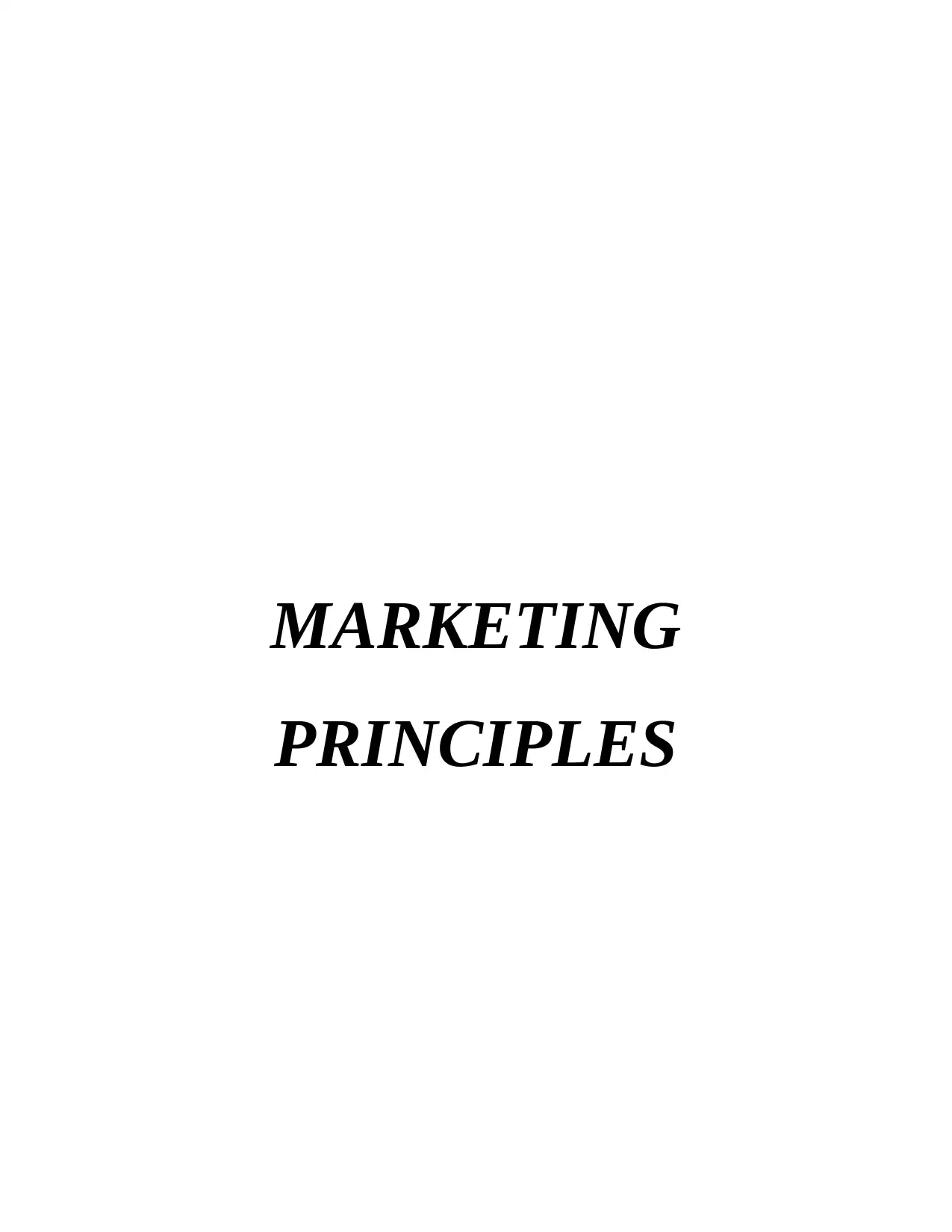
MARKETING
PRINCIPLES
PRINCIPLES
Paraphrase This Document
Need a fresh take? Get an instant paraphrase of this document with our AI Paraphraser
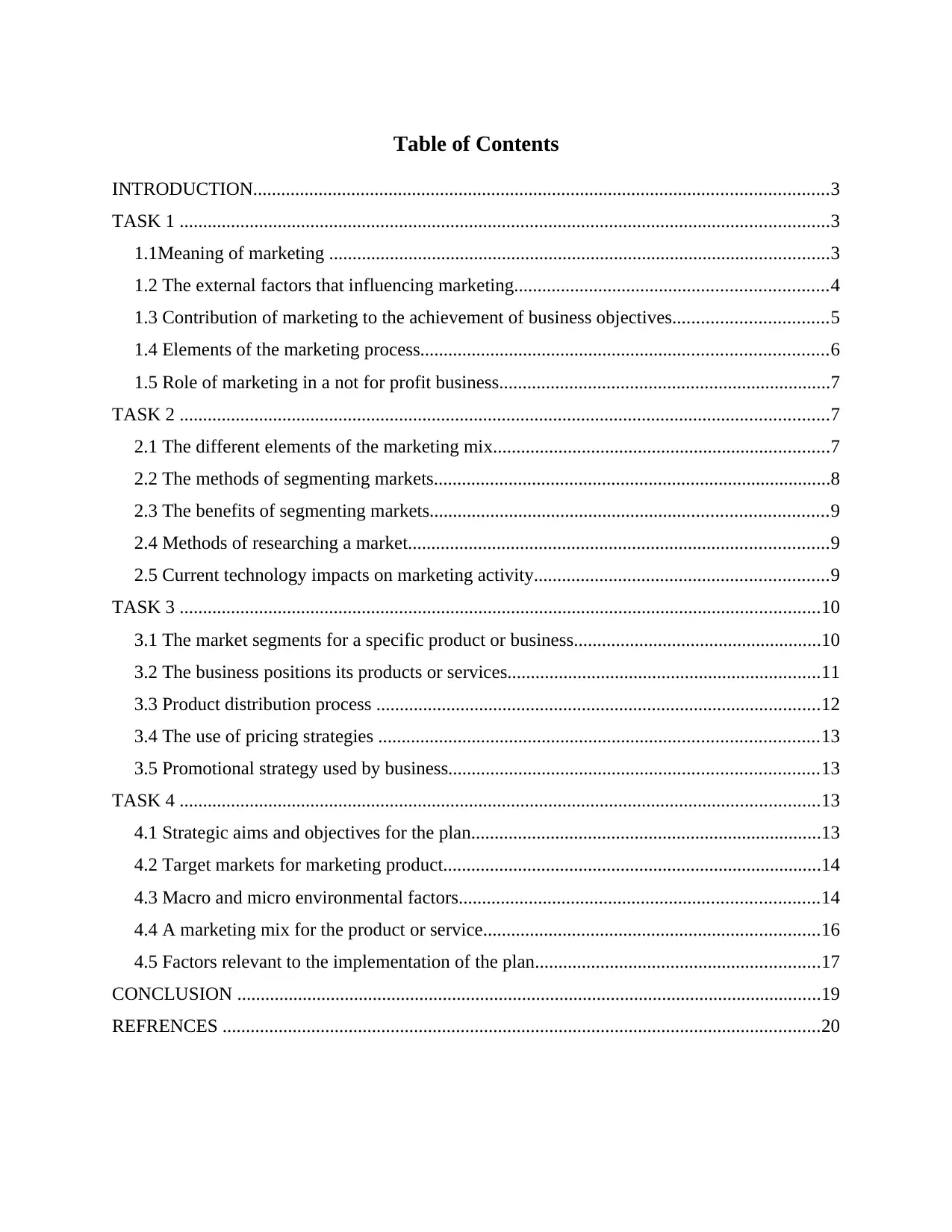
Table of Contents
INTRODUCTION...........................................................................................................................3
TASK 1 ...........................................................................................................................................3
1.1Meaning of marketing ...........................................................................................................3
1.2 The external factors that influencing marketing...................................................................4
1.3 Contribution of marketing to the achievement of business objectives.................................5
1.4 Elements of the marketing process.......................................................................................6
1.5 Role of marketing in a not for profit business.......................................................................7
TASK 2 ...........................................................................................................................................7
2.1 The different elements of the marketing mix........................................................................7
2.2 The methods of segmenting markets.....................................................................................8
2.3 The benefits of segmenting markets.....................................................................................9
2.4 Methods of researching a market..........................................................................................9
2.5 Current technology impacts on marketing activity...............................................................9
TASK 3 .........................................................................................................................................10
3.1 The market segments for a specific product or business.....................................................10
3.2 The business positions its products or services...................................................................11
3.3 Product distribution process ...............................................................................................12
3.4 The use of pricing strategies ..............................................................................................13
3.5 Promotional strategy used by business...............................................................................13
TASK 4 .........................................................................................................................................13
4.1 Strategic aims and objectives for the plan...........................................................................13
4.2 Target markets for marketing product.................................................................................14
4.3 Macro and micro environmental factors.............................................................................14
4.4 A marketing mix for the product or service........................................................................16
4.5 Factors relevant to the implementation of the plan.............................................................17
CONCLUSION .............................................................................................................................19
REFRENCES ................................................................................................................................20
INTRODUCTION...........................................................................................................................3
TASK 1 ...........................................................................................................................................3
1.1Meaning of marketing ...........................................................................................................3
1.2 The external factors that influencing marketing...................................................................4
1.3 Contribution of marketing to the achievement of business objectives.................................5
1.4 Elements of the marketing process.......................................................................................6
1.5 Role of marketing in a not for profit business.......................................................................7
TASK 2 ...........................................................................................................................................7
2.1 The different elements of the marketing mix........................................................................7
2.2 The methods of segmenting markets.....................................................................................8
2.3 The benefits of segmenting markets.....................................................................................9
2.4 Methods of researching a market..........................................................................................9
2.5 Current technology impacts on marketing activity...............................................................9
TASK 3 .........................................................................................................................................10
3.1 The market segments for a specific product or business.....................................................10
3.2 The business positions its products or services...................................................................11
3.3 Product distribution process ...............................................................................................12
3.4 The use of pricing strategies ..............................................................................................13
3.5 Promotional strategy used by business...............................................................................13
TASK 4 .........................................................................................................................................13
4.1 Strategic aims and objectives for the plan...........................................................................13
4.2 Target markets for marketing product.................................................................................14
4.3 Macro and micro environmental factors.............................................................................14
4.4 A marketing mix for the product or service........................................................................16
4.5 Factors relevant to the implementation of the plan.............................................................17
CONCLUSION .............................................................................................................................19
REFRENCES ................................................................................................................................20
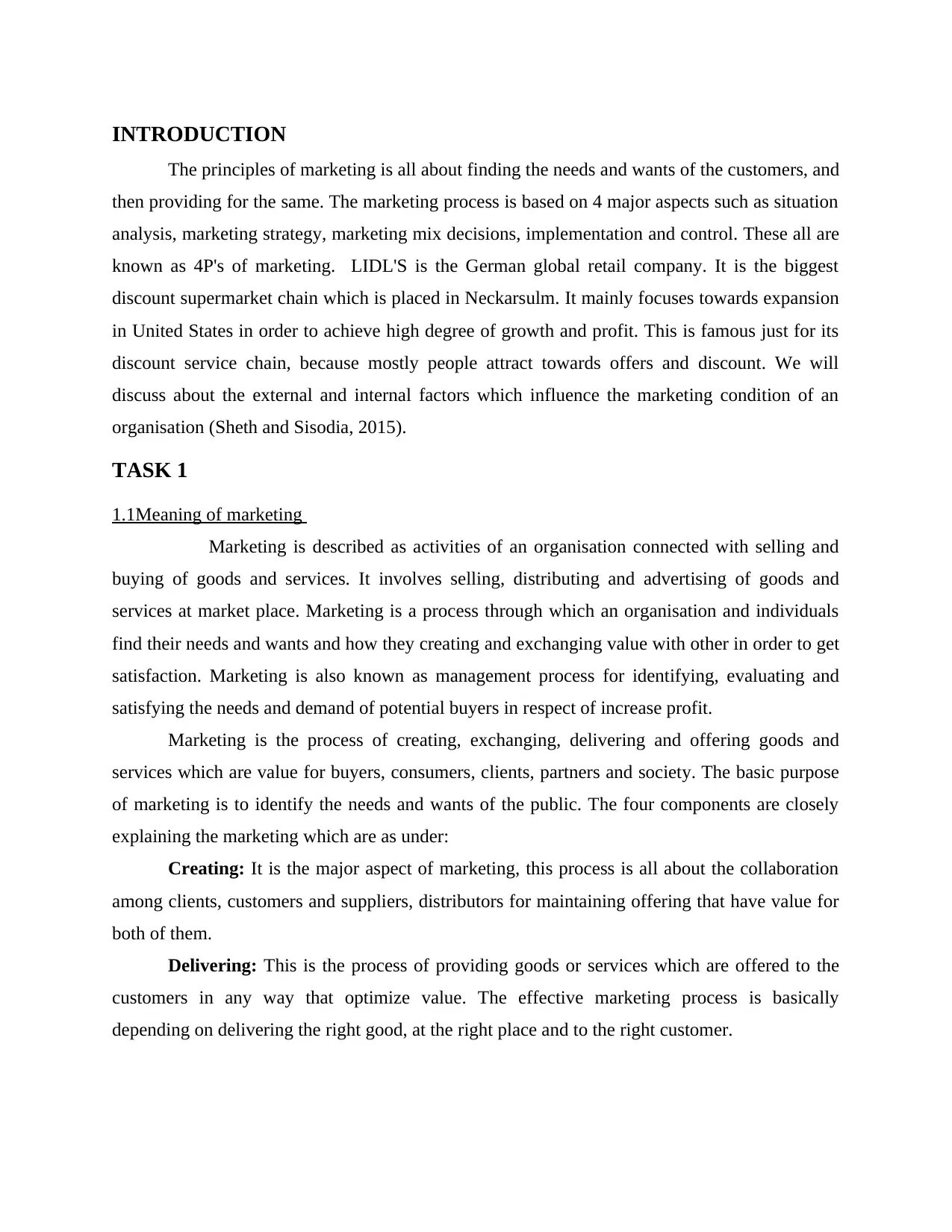
INTRODUCTION
The principles of marketing is all about finding the needs and wants of the customers, and
then providing for the same. The marketing process is based on 4 major aspects such as situation
analysis, marketing strategy, marketing mix decisions, implementation and control. These all are
known as 4P's of marketing. LIDL'S is the German global retail company. It is the biggest
discount supermarket chain which is placed in Neckarsulm. It mainly focuses towards expansion
in United States in order to achieve high degree of growth and profit. This is famous just for its
discount service chain, because mostly people attract towards offers and discount. We will
discuss about the external and internal factors which influence the marketing condition of an
organisation (Sheth and Sisodia, 2015).
TASK 1
1.1Meaning of marketing
Marketing is described as activities of an organisation connected with selling and
buying of goods and services. It involves selling, distributing and advertising of goods and
services at market place. Marketing is a process through which an organisation and individuals
find their needs and wants and how they creating and exchanging value with other in order to get
satisfaction. Marketing is also known as management process for identifying, evaluating and
satisfying the needs and demand of potential buyers in respect of increase profit.
Marketing is the process of creating, exchanging, delivering and offering goods and
services which are value for buyers, consumers, clients, partners and society. The basic purpose
of marketing is to identify the needs and wants of the public. The four components are closely
explaining the marketing which are as under:
Creating: It is the major aspect of marketing, this process is all about the collaboration
among clients, customers and suppliers, distributors for maintaining offering that have value for
both of them.
Delivering: This is the process of providing goods or services which are offered to the
customers in any way that optimize value. The effective marketing process is basically
depending on delivering the right good, at the right place and to the right customer.
The principles of marketing is all about finding the needs and wants of the customers, and
then providing for the same. The marketing process is based on 4 major aspects such as situation
analysis, marketing strategy, marketing mix decisions, implementation and control. These all are
known as 4P's of marketing. LIDL'S is the German global retail company. It is the biggest
discount supermarket chain which is placed in Neckarsulm. It mainly focuses towards expansion
in United States in order to achieve high degree of growth and profit. This is famous just for its
discount service chain, because mostly people attract towards offers and discount. We will
discuss about the external and internal factors which influence the marketing condition of an
organisation (Sheth and Sisodia, 2015).
TASK 1
1.1Meaning of marketing
Marketing is described as activities of an organisation connected with selling and
buying of goods and services. It involves selling, distributing and advertising of goods and
services at market place. Marketing is a process through which an organisation and individuals
find their needs and wants and how they creating and exchanging value with other in order to get
satisfaction. Marketing is also known as management process for identifying, evaluating and
satisfying the needs and demand of potential buyers in respect of increase profit.
Marketing is the process of creating, exchanging, delivering and offering goods and
services which are value for buyers, consumers, clients, partners and society. The basic purpose
of marketing is to identify the needs and wants of the public. The four components are closely
explaining the marketing which are as under:
Creating: It is the major aspect of marketing, this process is all about the collaboration
among clients, customers and suppliers, distributors for maintaining offering that have value for
both of them.
Delivering: This is the process of providing goods or services which are offered to the
customers in any way that optimize value. The effective marketing process is basically
depending on delivering the right good, at the right place and to the right customer.
⊘ This is a preview!⊘
Do you want full access?
Subscribe today to unlock all pages.

Trusted by 1+ million students worldwide
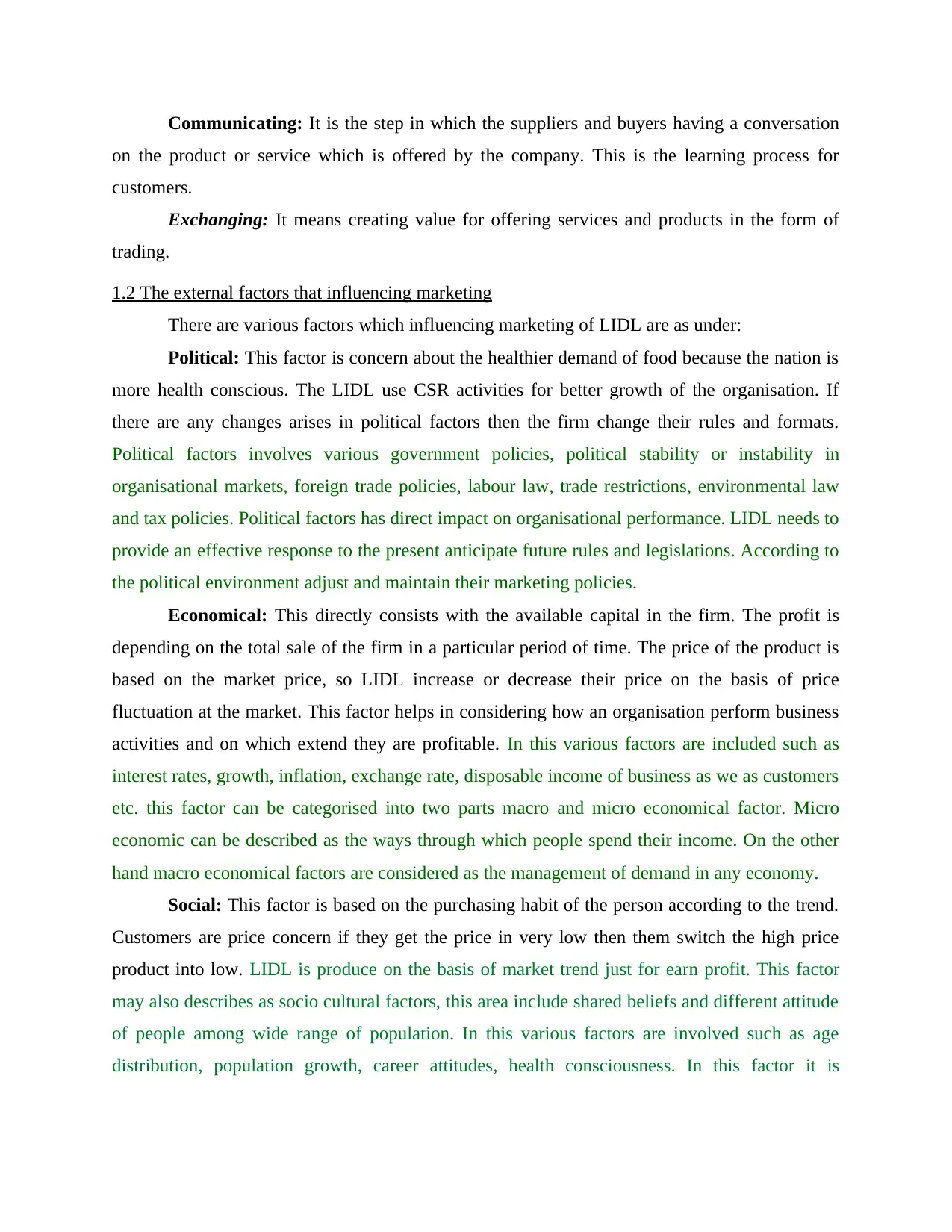
Communicating: It is the step in which the suppliers and buyers having a conversation
on the product or service which is offered by the company. This is the learning process for
customers.
Exchanging: It means creating value for offering services and products in the form of
trading.
1.2 The external factors that influencing marketing
There are various factors which influencing marketing of LIDL are as under:
Political: This factor is concern about the healthier demand of food because the nation is
more health conscious. The LIDL use CSR activities for better growth of the organisation. If
there are any changes arises in political factors then the firm change their rules and formats.
Political factors involves various government policies, political stability or instability in
organisational markets, foreign trade policies, labour law, trade restrictions, environmental law
and tax policies. Political factors has direct impact on organisational performance. LIDL needs to
provide an effective response to the present anticipate future rules and legislations. According to
the political environment adjust and maintain their marketing policies.
Economical: This directly consists with the available capital in the firm. The profit is
depending on the total sale of the firm in a particular period of time. The price of the product is
based on the market price, so LIDL increase or decrease their price on the basis of price
fluctuation at the market. This factor helps in considering how an organisation perform business
activities and on which extend they are profitable. In this various factors are included such as
interest rates, growth, inflation, exchange rate, disposable income of business as we as customers
etc. this factor can be categorised into two parts macro and micro economical factor. Micro
economic can be described as the ways through which people spend their income. On the other
hand macro economical factors are considered as the management of demand in any economy.
Social: This factor is based on the purchasing habit of the person according to the trend.
Customers are price concern if they get the price in very low then them switch the high price
product into low. LIDL is produce on the basis of market trend just for earn profit. This factor
may also describes as socio cultural factors, this area include shared beliefs and different attitude
of people among wide range of population. In this various factors are involved such as age
distribution, population growth, career attitudes, health consciousness. In this factor it is
on the product or service which is offered by the company. This is the learning process for
customers.
Exchanging: It means creating value for offering services and products in the form of
trading.
1.2 The external factors that influencing marketing
There are various factors which influencing marketing of LIDL are as under:
Political: This factor is concern about the healthier demand of food because the nation is
more health conscious. The LIDL use CSR activities for better growth of the organisation. If
there are any changes arises in political factors then the firm change their rules and formats.
Political factors involves various government policies, political stability or instability in
organisational markets, foreign trade policies, labour law, trade restrictions, environmental law
and tax policies. Political factors has direct impact on organisational performance. LIDL needs to
provide an effective response to the present anticipate future rules and legislations. According to
the political environment adjust and maintain their marketing policies.
Economical: This directly consists with the available capital in the firm. The profit is
depending on the total sale of the firm in a particular period of time. The price of the product is
based on the market price, so LIDL increase or decrease their price on the basis of price
fluctuation at the market. This factor helps in considering how an organisation perform business
activities and on which extend they are profitable. In this various factors are included such as
interest rates, growth, inflation, exchange rate, disposable income of business as we as customers
etc. this factor can be categorised into two parts macro and micro economical factor. Micro
economic can be described as the ways through which people spend their income. On the other
hand macro economical factors are considered as the management of demand in any economy.
Social: This factor is based on the purchasing habit of the person according to the trend.
Customers are price concern if they get the price in very low then them switch the high price
product into low. LIDL is produce on the basis of market trend just for earn profit. This factor
may also describes as socio cultural factors, this area include shared beliefs and different attitude
of people among wide range of population. In this various factors are involved such as age
distribution, population growth, career attitudes, health consciousness. In this factor it is
Paraphrase This Document
Need a fresh take? Get an instant paraphrase of this document with our AI Paraphraser
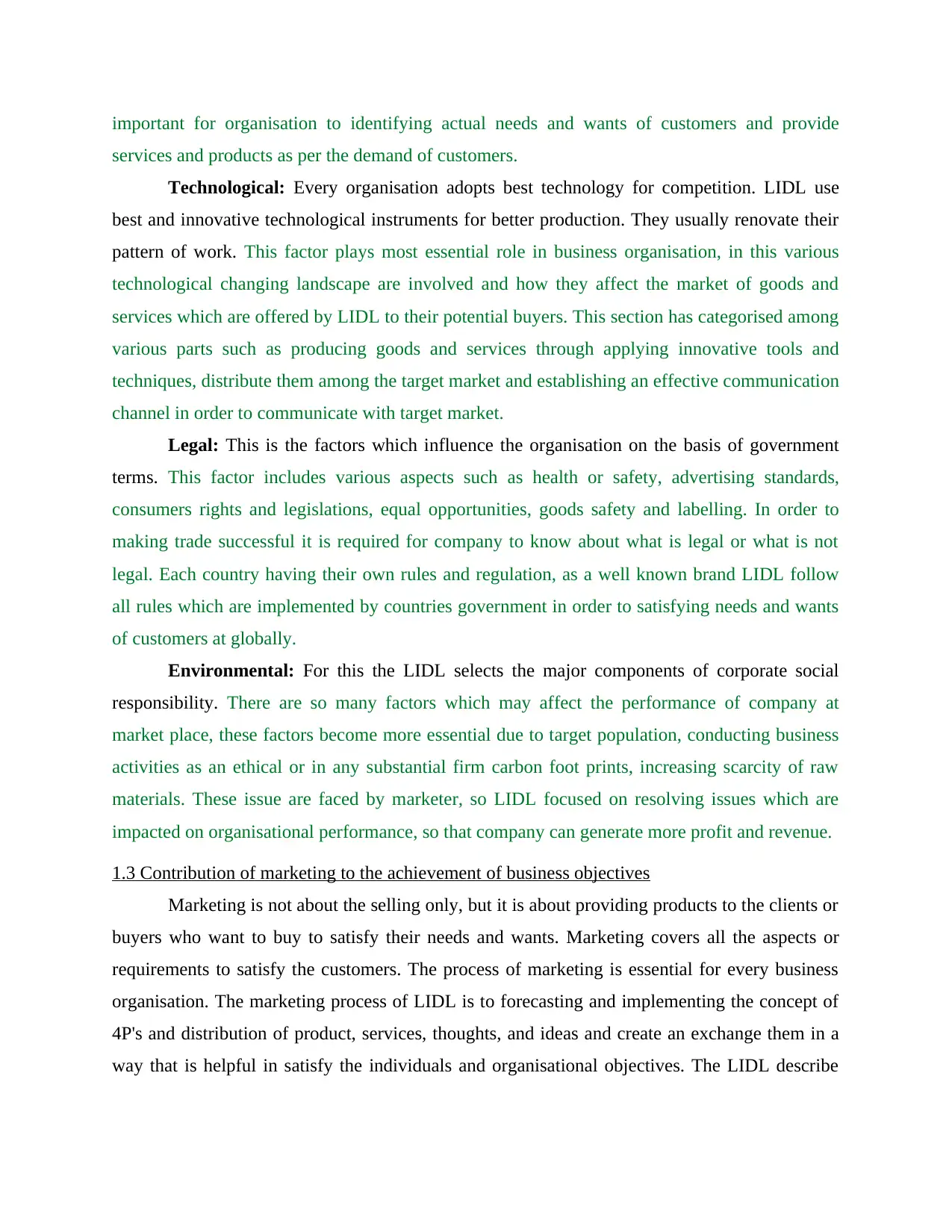
important for organisation to identifying actual needs and wants of customers and provide
services and products as per the demand of customers.
Technological: Every organisation adopts best technology for competition. LIDL use
best and innovative technological instruments for better production. They usually renovate their
pattern of work. This factor plays most essential role in business organisation, in this various
technological changing landscape are involved and how they affect the market of goods and
services which are offered by LIDL to their potential buyers. This section has categorised among
various parts such as producing goods and services through applying innovative tools and
techniques, distribute them among the target market and establishing an effective communication
channel in order to communicate with target market.
Legal: This is the factors which influence the organisation on the basis of government
terms. This factor includes various aspects such as health or safety, advertising standards,
consumers rights and legislations, equal opportunities, goods safety and labelling. In order to
making trade successful it is required for company to know about what is legal or what is not
legal. Each country having their own rules and regulation, as a well known brand LIDL follow
all rules which are implemented by countries government in order to satisfying needs and wants
of customers at globally.
Environmental: For this the LIDL selects the major components of corporate social
responsibility. There are so many factors which may affect the performance of company at
market place, these factors become more essential due to target population, conducting business
activities as an ethical or in any substantial firm carbon foot prints, increasing scarcity of raw
materials. These issue are faced by marketer, so LIDL focused on resolving issues which are
impacted on organisational performance, so that company can generate more profit and revenue.
1.3 Contribution of marketing to the achievement of business objectives
Marketing is not about the selling only, but it is about providing products to the clients or
buyers who want to buy to satisfy their needs and wants. Marketing covers all the aspects or
requirements to satisfy the customers. The process of marketing is essential for every business
organisation. The marketing process of LIDL is to forecasting and implementing the concept of
4P's and distribution of product, services, thoughts, and ideas and create an exchange them in a
way that is helpful in satisfy the individuals and organisational objectives. The LIDL describe
services and products as per the demand of customers.
Technological: Every organisation adopts best technology for competition. LIDL use
best and innovative technological instruments for better production. They usually renovate their
pattern of work. This factor plays most essential role in business organisation, in this various
technological changing landscape are involved and how they affect the market of goods and
services which are offered by LIDL to their potential buyers. This section has categorised among
various parts such as producing goods and services through applying innovative tools and
techniques, distribute them among the target market and establishing an effective communication
channel in order to communicate with target market.
Legal: This is the factors which influence the organisation on the basis of government
terms. This factor includes various aspects such as health or safety, advertising standards,
consumers rights and legislations, equal opportunities, goods safety and labelling. In order to
making trade successful it is required for company to know about what is legal or what is not
legal. Each country having their own rules and regulation, as a well known brand LIDL follow
all rules which are implemented by countries government in order to satisfying needs and wants
of customers at globally.
Environmental: For this the LIDL selects the major components of corporate social
responsibility. There are so many factors which may affect the performance of company at
market place, these factors become more essential due to target population, conducting business
activities as an ethical or in any substantial firm carbon foot prints, increasing scarcity of raw
materials. These issue are faced by marketer, so LIDL focused on resolving issues which are
impacted on organisational performance, so that company can generate more profit and revenue.
1.3 Contribution of marketing to the achievement of business objectives
Marketing is not about the selling only, but it is about providing products to the clients or
buyers who want to buy to satisfy their needs and wants. Marketing covers all the aspects or
requirements to satisfy the customers. The process of marketing is essential for every business
organisation. The marketing process of LIDL is to forecasting and implementing the concept of
4P's and distribution of product, services, thoughts, and ideas and create an exchange them in a
way that is helpful in satisfy the individuals and organisational objectives. The LIDL describe
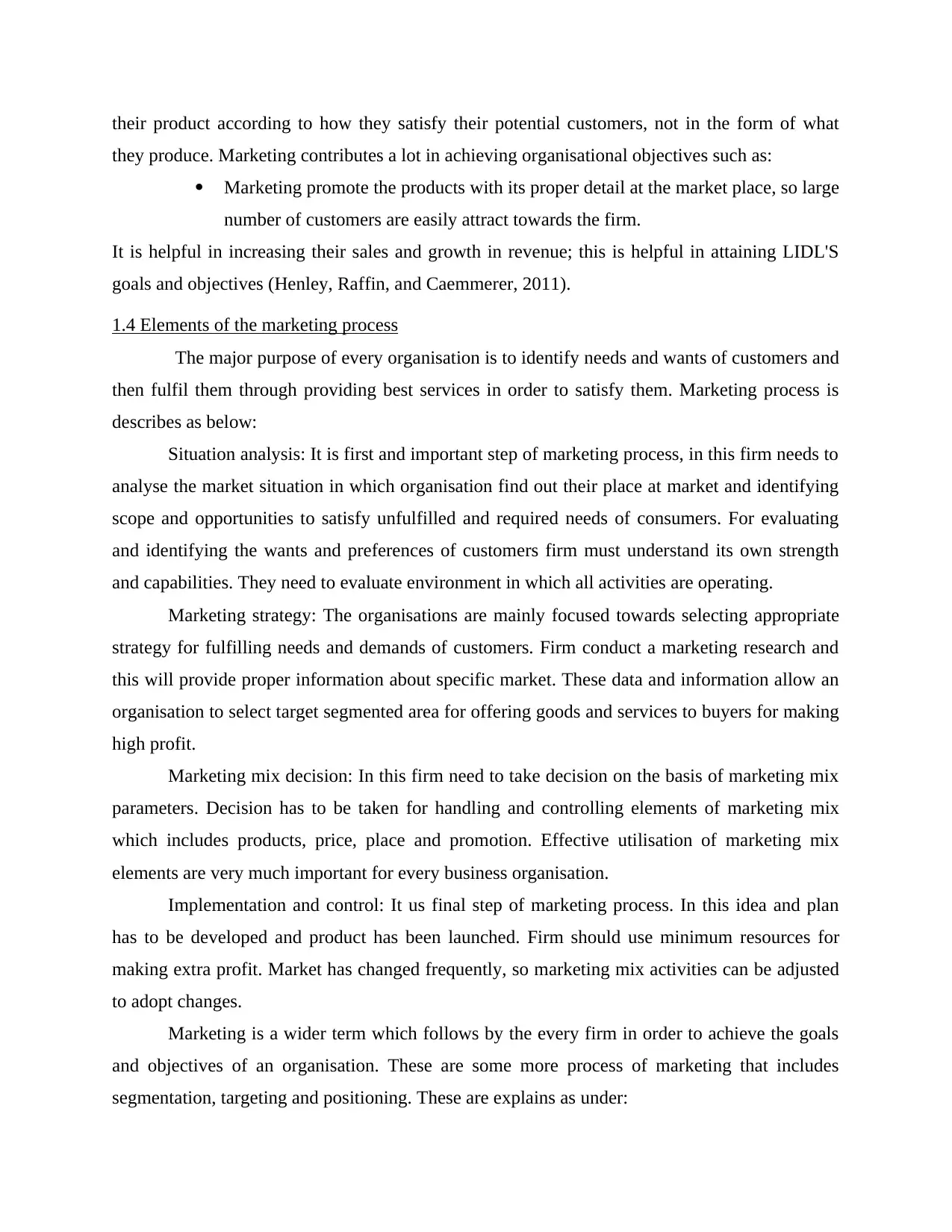
their product according to how they satisfy their potential customers, not in the form of what
they produce. Marketing contributes a lot in achieving organisational objectives such as:
Marketing promote the products with its proper detail at the market place, so large
number of customers are easily attract towards the firm.
It is helpful in increasing their sales and growth in revenue; this is helpful in attaining LIDL'S
goals and objectives (Henley, Raffin, and Caemmerer, 2011).
1.4 Elements of the marketing process
The major purpose of every organisation is to identify needs and wants of customers and
then fulfil them through providing best services in order to satisfy them. Marketing process is
describes as below:
Situation analysis: It is first and important step of marketing process, in this firm needs to
analyse the market situation in which organisation find out their place at market and identifying
scope and opportunities to satisfy unfulfilled and required needs of consumers. For evaluating
and identifying the wants and preferences of customers firm must understand its own strength
and capabilities. They need to evaluate environment in which all activities are operating.
Marketing strategy: The organisations are mainly focused towards selecting appropriate
strategy for fulfilling needs and demands of customers. Firm conduct a marketing research and
this will provide proper information about specific market. These data and information allow an
organisation to select target segmented area for offering goods and services to buyers for making
high profit.
Marketing mix decision: In this firm need to take decision on the basis of marketing mix
parameters. Decision has to be taken for handling and controlling elements of marketing mix
which includes products, price, place and promotion. Effective utilisation of marketing mix
elements are very much important for every business organisation.
Implementation and control: It us final step of marketing process. In this idea and plan
has to be developed and product has been launched. Firm should use minimum resources for
making extra profit. Market has changed frequently, so marketing mix activities can be adjusted
to adopt changes.
Marketing is a wider term which follows by the every firm in order to achieve the goals
and objectives of an organisation. These are some more process of marketing that includes
segmentation, targeting and positioning. These are explains as under:
they produce. Marketing contributes a lot in achieving organisational objectives such as:
Marketing promote the products with its proper detail at the market place, so large
number of customers are easily attract towards the firm.
It is helpful in increasing their sales and growth in revenue; this is helpful in attaining LIDL'S
goals and objectives (Henley, Raffin, and Caemmerer, 2011).
1.4 Elements of the marketing process
The major purpose of every organisation is to identify needs and wants of customers and
then fulfil them through providing best services in order to satisfy them. Marketing process is
describes as below:
Situation analysis: It is first and important step of marketing process, in this firm needs to
analyse the market situation in which organisation find out their place at market and identifying
scope and opportunities to satisfy unfulfilled and required needs of consumers. For evaluating
and identifying the wants and preferences of customers firm must understand its own strength
and capabilities. They need to evaluate environment in which all activities are operating.
Marketing strategy: The organisations are mainly focused towards selecting appropriate
strategy for fulfilling needs and demands of customers. Firm conduct a marketing research and
this will provide proper information about specific market. These data and information allow an
organisation to select target segmented area for offering goods and services to buyers for making
high profit.
Marketing mix decision: In this firm need to take decision on the basis of marketing mix
parameters. Decision has to be taken for handling and controlling elements of marketing mix
which includes products, price, place and promotion. Effective utilisation of marketing mix
elements are very much important for every business organisation.
Implementation and control: It us final step of marketing process. In this idea and plan
has to be developed and product has been launched. Firm should use minimum resources for
making extra profit. Market has changed frequently, so marketing mix activities can be adjusted
to adopt changes.
Marketing is a wider term which follows by the every firm in order to achieve the goals
and objectives of an organisation. These are some more process of marketing that includes
segmentation, targeting and positioning. These are explains as under:
⊘ This is a preview!⊘
Do you want full access?
Subscribe today to unlock all pages.

Trusted by 1+ million students worldwide
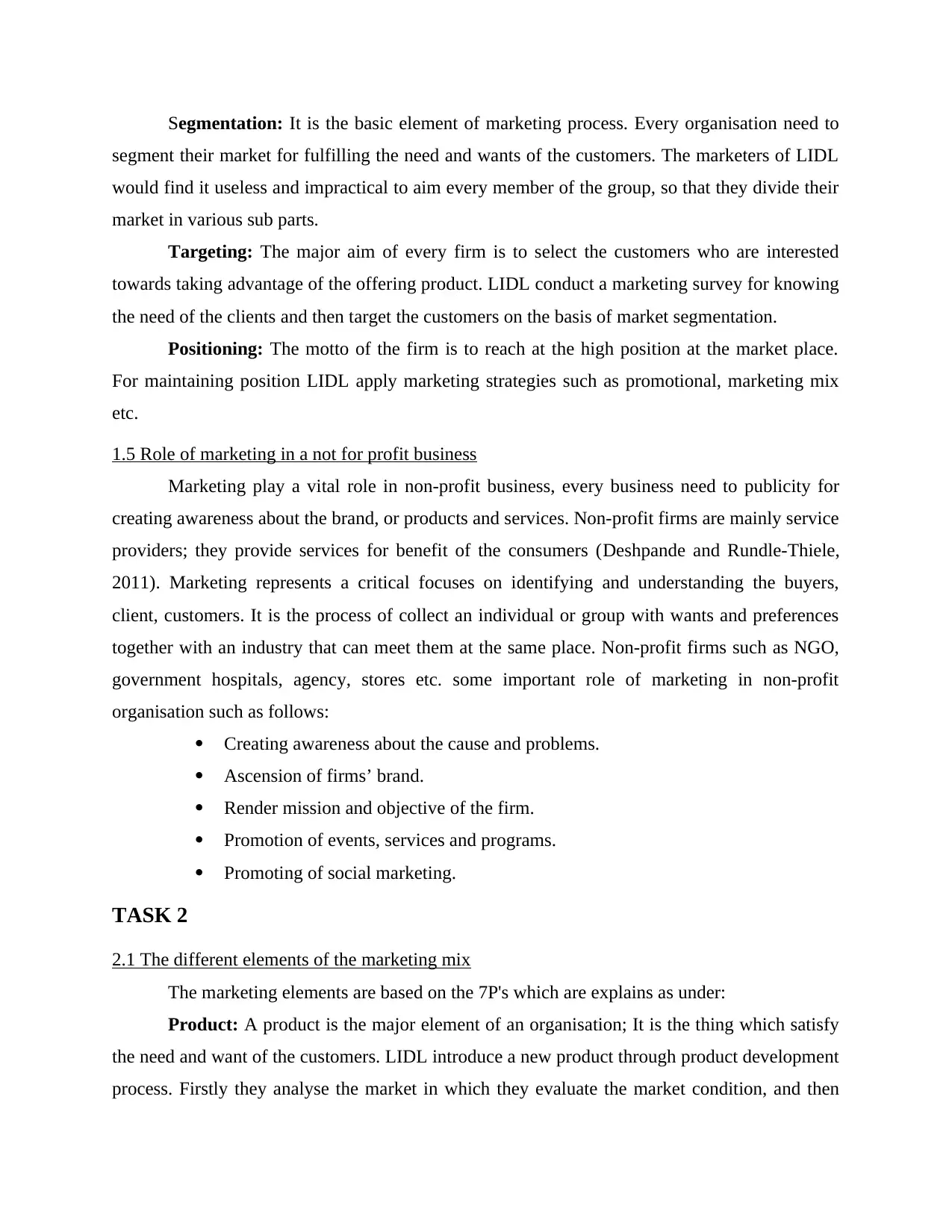
Segmentation: It is the basic element of marketing process. Every organisation need to
segment their market for fulfilling the need and wants of the customers. The marketers of LIDL
would find it useless and impractical to aim every member of the group, so that they divide their
market in various sub parts.
Targeting: The major aim of every firm is to select the customers who are interested
towards taking advantage of the offering product. LIDL conduct a marketing survey for knowing
the need of the clients and then target the customers on the basis of market segmentation.
Positioning: The motto of the firm is to reach at the high position at the market place.
For maintaining position LIDL apply marketing strategies such as promotional, marketing mix
etc.
1.5 Role of marketing in a not for profit business
Marketing play a vital role in non-profit business, every business need to publicity for
creating awareness about the brand, or products and services. Non-profit firms are mainly service
providers; they provide services for benefit of the consumers (Deshpande and Rundle-Thiele,
2011). Marketing represents a critical focuses on identifying and understanding the buyers,
client, customers. It is the process of collect an individual or group with wants and preferences
together with an industry that can meet them at the same place. Non-profit firms such as NGO,
government hospitals, agency, stores etc. some important role of marketing in non-profit
organisation such as follows:
Creating awareness about the cause and problems.
Ascension of firms’ brand.
Render mission and objective of the firm.
Promotion of events, services and programs.
Promoting of social marketing.
TASK 2
2.1 The different elements of the marketing mix
The marketing elements are based on the 7P's which are explains as under:
Product: A product is the major element of an organisation; It is the thing which satisfy
the need and want of the customers. LIDL introduce a new product through product development
process. Firstly they analyse the market in which they evaluate the market condition, and then
segment their market for fulfilling the need and wants of the customers. The marketers of LIDL
would find it useless and impractical to aim every member of the group, so that they divide their
market in various sub parts.
Targeting: The major aim of every firm is to select the customers who are interested
towards taking advantage of the offering product. LIDL conduct a marketing survey for knowing
the need of the clients and then target the customers on the basis of market segmentation.
Positioning: The motto of the firm is to reach at the high position at the market place.
For maintaining position LIDL apply marketing strategies such as promotional, marketing mix
etc.
1.5 Role of marketing in a not for profit business
Marketing play a vital role in non-profit business, every business need to publicity for
creating awareness about the brand, or products and services. Non-profit firms are mainly service
providers; they provide services for benefit of the consumers (Deshpande and Rundle-Thiele,
2011). Marketing represents a critical focuses on identifying and understanding the buyers,
client, customers. It is the process of collect an individual or group with wants and preferences
together with an industry that can meet them at the same place. Non-profit firms such as NGO,
government hospitals, agency, stores etc. some important role of marketing in non-profit
organisation such as follows:
Creating awareness about the cause and problems.
Ascension of firms’ brand.
Render mission and objective of the firm.
Promotion of events, services and programs.
Promoting of social marketing.
TASK 2
2.1 The different elements of the marketing mix
The marketing elements are based on the 7P's which are explains as under:
Product: A product is the major element of an organisation; It is the thing which satisfy
the need and want of the customers. LIDL introduce a new product through product development
process. Firstly they analyse the market in which they evaluate the market condition, and then
Paraphrase This Document
Need a fresh take? Get an instant paraphrase of this document with our AI Paraphraser
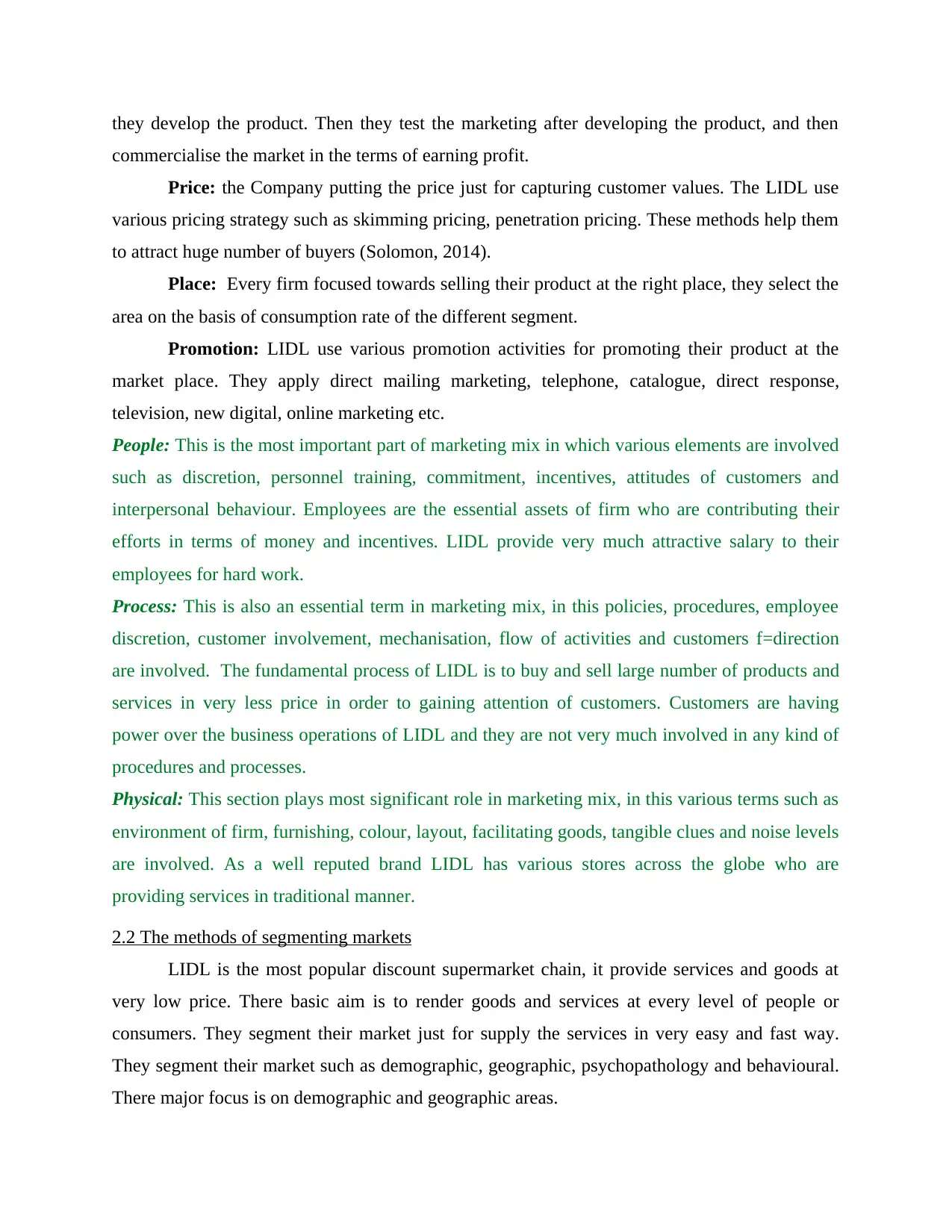
they develop the product. Then they test the marketing after developing the product, and then
commercialise the market in the terms of earning profit.
Price: the Company putting the price just for capturing customer values. The LIDL use
various pricing strategy such as skimming pricing, penetration pricing. These methods help them
to attract huge number of buyers (Solomon, 2014).
Place: Every firm focused towards selling their product at the right place, they select the
area on the basis of consumption rate of the different segment.
Promotion: LIDL use various promotion activities for promoting their product at the
market place. They apply direct mailing marketing, telephone, catalogue, direct response,
television, new digital, online marketing etc.
People: This is the most important part of marketing mix in which various elements are involved
such as discretion, personnel training, commitment, incentives, attitudes of customers and
interpersonal behaviour. Employees are the essential assets of firm who are contributing their
efforts in terms of money and incentives. LIDL provide very much attractive salary to their
employees for hard work.
Process: This is also an essential term in marketing mix, in this policies, procedures, employee
discretion, customer involvement, mechanisation, flow of activities and customers f=direction
are involved. The fundamental process of LIDL is to buy and sell large number of products and
services in very less price in order to gaining attention of customers. Customers are having
power over the business operations of LIDL and they are not very much involved in any kind of
procedures and processes.
Physical: This section plays most significant role in marketing mix, in this various terms such as
environment of firm, furnishing, colour, layout, facilitating goods, tangible clues and noise levels
are involved. As a well reputed brand LIDL has various stores across the globe who are
providing services in traditional manner.
2.2 The methods of segmenting markets
LIDL is the most popular discount supermarket chain, it provide services and goods at
very low price. There basic aim is to render goods and services at every level of people or
consumers. They segment their market just for supply the services in very easy and fast way.
They segment their market such as demographic, geographic, psychopathology and behavioural.
There major focus is on demographic and geographic areas.
commercialise the market in the terms of earning profit.
Price: the Company putting the price just for capturing customer values. The LIDL use
various pricing strategy such as skimming pricing, penetration pricing. These methods help them
to attract huge number of buyers (Solomon, 2014).
Place: Every firm focused towards selling their product at the right place, they select the
area on the basis of consumption rate of the different segment.
Promotion: LIDL use various promotion activities for promoting their product at the
market place. They apply direct mailing marketing, telephone, catalogue, direct response,
television, new digital, online marketing etc.
People: This is the most important part of marketing mix in which various elements are involved
such as discretion, personnel training, commitment, incentives, attitudes of customers and
interpersonal behaviour. Employees are the essential assets of firm who are contributing their
efforts in terms of money and incentives. LIDL provide very much attractive salary to their
employees for hard work.
Process: This is also an essential term in marketing mix, in this policies, procedures, employee
discretion, customer involvement, mechanisation, flow of activities and customers f=direction
are involved. The fundamental process of LIDL is to buy and sell large number of products and
services in very less price in order to gaining attention of customers. Customers are having
power over the business operations of LIDL and they are not very much involved in any kind of
procedures and processes.
Physical: This section plays most significant role in marketing mix, in this various terms such as
environment of firm, furnishing, colour, layout, facilitating goods, tangible clues and noise levels
are involved. As a well reputed brand LIDL has various stores across the globe who are
providing services in traditional manner.
2.2 The methods of segmenting markets
LIDL is the most popular discount supermarket chain, it provide services and goods at
very low price. There basic aim is to render goods and services at every level of people or
consumers. They segment their market just for supply the services in very easy and fast way.
They segment their market such as demographic, geographic, psychopathology and behavioural.
There major focus is on demographic and geographic areas.
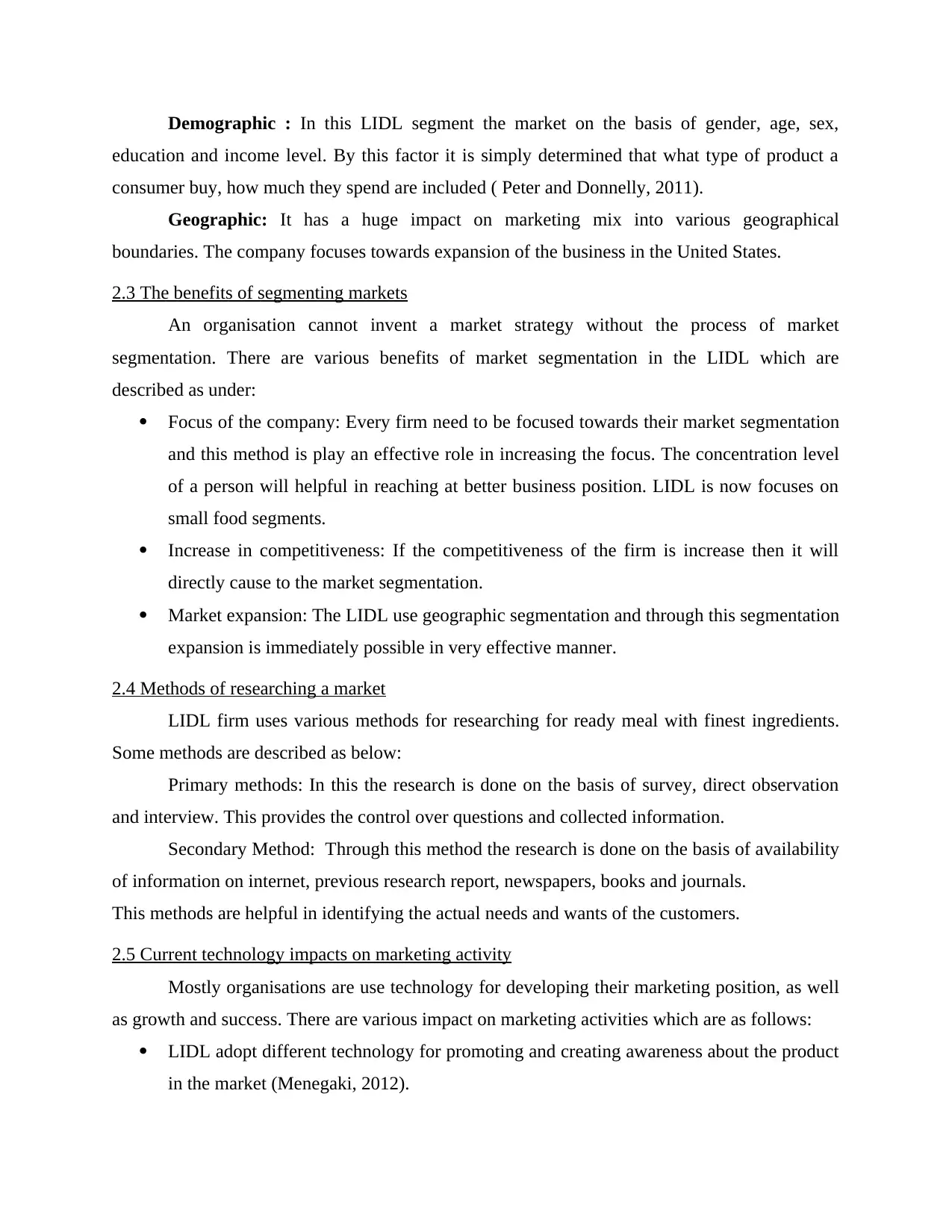
Demographic : In this LIDL segment the market on the basis of gender, age, sex,
education and income level. By this factor it is simply determined that what type of product a
consumer buy, how much they spend are included ( Peter and Donnelly, 2011).
Geographic: It has a huge impact on marketing mix into various geographical
boundaries. The company focuses towards expansion of the business in the United States.
2.3 The benefits of segmenting markets
An organisation cannot invent a market strategy without the process of market
segmentation. There are various benefits of market segmentation in the LIDL which are
described as under:
Focus of the company: Every firm need to be focused towards their market segmentation
and this method is play an effective role in increasing the focus. The concentration level
of a person will helpful in reaching at better business position. LIDL is now focuses on
small food segments.
Increase in competitiveness: If the competitiveness of the firm is increase then it will
directly cause to the market segmentation.
Market expansion: The LIDL use geographic segmentation and through this segmentation
expansion is immediately possible in very effective manner.
2.4 Methods of researching a market
LIDL firm uses various methods for researching for ready meal with finest ingredients.
Some methods are described as below:
Primary methods: In this the research is done on the basis of survey, direct observation
and interview. This provides the control over questions and collected information.
Secondary Method: Through this method the research is done on the basis of availability
of information on internet, previous research report, newspapers, books and journals.
This methods are helpful in identifying the actual needs and wants of the customers.
2.5 Current technology impacts on marketing activity
Mostly organisations are use technology for developing their marketing position, as well
as growth and success. There are various impact on marketing activities which are as follows:
LIDL adopt different technology for promoting and creating awareness about the product
in the market (Menegaki, 2012).
education and income level. By this factor it is simply determined that what type of product a
consumer buy, how much they spend are included ( Peter and Donnelly, 2011).
Geographic: It has a huge impact on marketing mix into various geographical
boundaries. The company focuses towards expansion of the business in the United States.
2.3 The benefits of segmenting markets
An organisation cannot invent a market strategy without the process of market
segmentation. There are various benefits of market segmentation in the LIDL which are
described as under:
Focus of the company: Every firm need to be focused towards their market segmentation
and this method is play an effective role in increasing the focus. The concentration level
of a person will helpful in reaching at better business position. LIDL is now focuses on
small food segments.
Increase in competitiveness: If the competitiveness of the firm is increase then it will
directly cause to the market segmentation.
Market expansion: The LIDL use geographic segmentation and through this segmentation
expansion is immediately possible in very effective manner.
2.4 Methods of researching a market
LIDL firm uses various methods for researching for ready meal with finest ingredients.
Some methods are described as below:
Primary methods: In this the research is done on the basis of survey, direct observation
and interview. This provides the control over questions and collected information.
Secondary Method: Through this method the research is done on the basis of availability
of information on internet, previous research report, newspapers, books and journals.
This methods are helpful in identifying the actual needs and wants of the customers.
2.5 Current technology impacts on marketing activity
Mostly organisations are use technology for developing their marketing position, as well
as growth and success. There are various impact on marketing activities which are as follows:
LIDL adopt different technology for promoting and creating awareness about the product
in the market (Menegaki, 2012).
⊘ This is a preview!⊘
Do you want full access?
Subscribe today to unlock all pages.

Trusted by 1+ million students worldwide
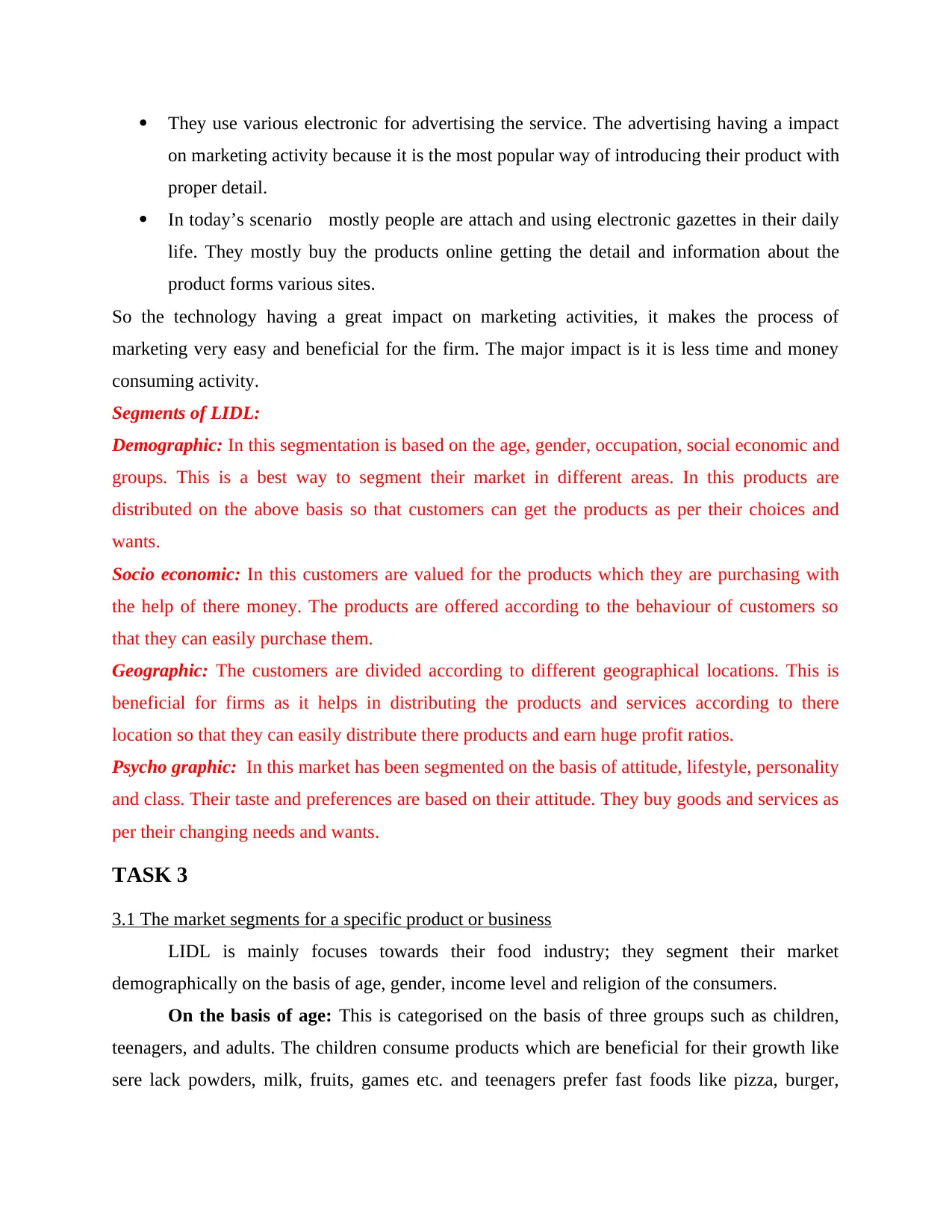
They use various electronic for advertising the service. The advertising having a impact
on marketing activity because it is the most popular way of introducing their product with
proper detail.
In today’s scenario mostly people are attach and using electronic gazettes in their daily
life. They mostly buy the products online getting the detail and information about the
product forms various sites.
So the technology having a great impact on marketing activities, it makes the process of
marketing very easy and beneficial for the firm. The major impact is it is less time and money
consuming activity.
Segments of LIDL:
Demographic: In this segmentation is based on the age, gender, occupation, social economic and
groups. This is a best way to segment their market in different areas. In this products are
distributed on the above basis so that customers can get the products as per their choices and
wants.
Socio economic: In this customers are valued for the products which they are purchasing with
the help of there money. The products are offered according to the behaviour of customers so
that they can easily purchase them.
Geographic: The customers are divided according to different geographical locations. This is
beneficial for firms as it helps in distributing the products and services according to there
location so that they can easily distribute there products and earn huge profit ratios.
Psycho graphic: In this market has been segmented on the basis of attitude, lifestyle, personality
and class. Their taste and preferences are based on their attitude. They buy goods and services as
per their changing needs and wants.
TASK 3
3.1 The market segments for a specific product or business
LIDL is mainly focuses towards their food industry; they segment their market
demographically on the basis of age, gender, income level and religion of the consumers.
On the basis of age: This is categorised on the basis of three groups such as children,
teenagers, and adults. The children consume products which are beneficial for their growth like
sere lack powders, milk, fruits, games etc. and teenagers prefer fast foods like pizza, burger,
on marketing activity because it is the most popular way of introducing their product with
proper detail.
In today’s scenario mostly people are attach and using electronic gazettes in their daily
life. They mostly buy the products online getting the detail and information about the
product forms various sites.
So the technology having a great impact on marketing activities, it makes the process of
marketing very easy and beneficial for the firm. The major impact is it is less time and money
consuming activity.
Segments of LIDL:
Demographic: In this segmentation is based on the age, gender, occupation, social economic and
groups. This is a best way to segment their market in different areas. In this products are
distributed on the above basis so that customers can get the products as per their choices and
wants.
Socio economic: In this customers are valued for the products which they are purchasing with
the help of there money. The products are offered according to the behaviour of customers so
that they can easily purchase them.
Geographic: The customers are divided according to different geographical locations. This is
beneficial for firms as it helps in distributing the products and services according to there
location so that they can easily distribute there products and earn huge profit ratios.
Psycho graphic: In this market has been segmented on the basis of attitude, lifestyle, personality
and class. Their taste and preferences are based on their attitude. They buy goods and services as
per their changing needs and wants.
TASK 3
3.1 The market segments for a specific product or business
LIDL is mainly focuses towards their food industry; they segment their market
demographically on the basis of age, gender, income level and religion of the consumers.
On the basis of age: This is categorised on the basis of three groups such as children,
teenagers, and adults. The children consume products which are beneficial for their growth like
sere lack powders, milk, fruits, games etc. and teenagers prefer fast foods like pizza, burger,
Paraphrase This Document
Need a fresh take? Get an instant paraphrase of this document with our AI Paraphraser
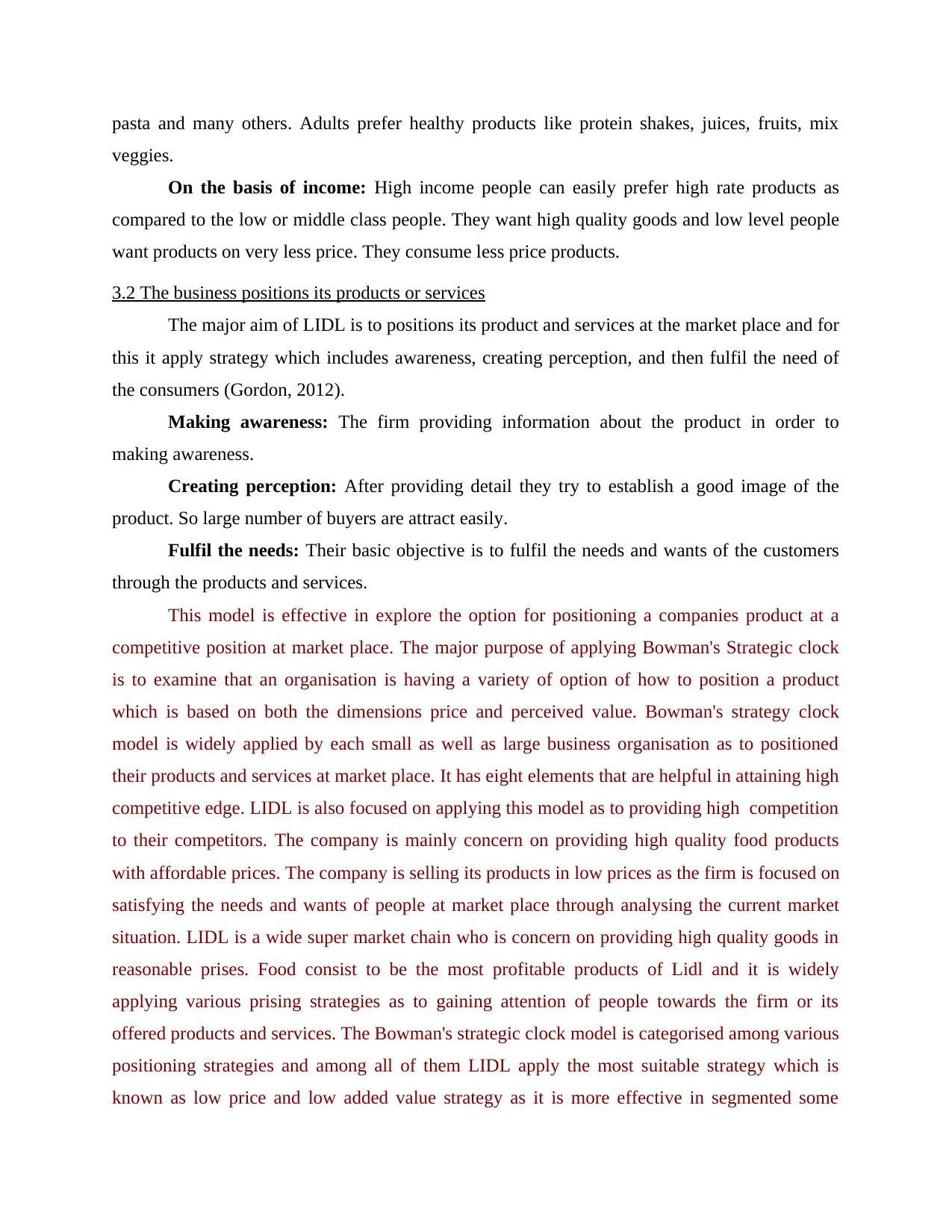
pasta and many others. Adults prefer healthy products like protein shakes, juices, fruits, mix
veggies.
On the basis of income: High income people can easily prefer high rate products as
compared to the low or middle class people. They want high quality goods and low level people
want products on very less price. They consume less price products.
3.2 The business positions its products or services
The major aim of LIDL is to positions its product and services at the market place and for
this it apply strategy which includes awareness, creating perception, and then fulfil the need of
the consumers (Gordon, 2012).
Making awareness: The firm providing information about the product in order to
making awareness.
Creating perception: After providing detail they try to establish a good image of the
product. So large number of buyers are attract easily.
Fulfil the needs: Their basic objective is to fulfil the needs and wants of the customers
through the products and services.
This model is effective in explore the option for positioning a companies product at a
competitive position at market place. The major purpose of applying Bowman's Strategic clock
is to examine that an organisation is having a variety of option of how to position a product
which is based on both the dimensions price and perceived value. Bowman's strategy clock
model is widely applied by each small as well as large business organisation as to positioned
their products and services at market place. It has eight elements that are helpful in attaining high
competitive edge. LIDL is also focused on applying this model as to providing high competition
to their competitors. The company is mainly concern on providing high quality food products
with affordable prices. The company is selling its products in low prices as the firm is focused on
satisfying the needs and wants of people at market place through analysing the current market
situation. LIDL is a wide super market chain who is concern on providing high quality goods in
reasonable prises. Food consist to be the most profitable products of Lidl and it is widely
applying various prising strategies as to gaining attention of people towards the firm or its
offered products and services. The Bowman's strategic clock model is categorised among various
positioning strategies and among all of them LIDL apply the most suitable strategy which is
known as low price and low added value strategy as it is more effective in segmented some
veggies.
On the basis of income: High income people can easily prefer high rate products as
compared to the low or middle class people. They want high quality goods and low level people
want products on very less price. They consume less price products.
3.2 The business positions its products or services
The major aim of LIDL is to positions its product and services at the market place and for
this it apply strategy which includes awareness, creating perception, and then fulfil the need of
the consumers (Gordon, 2012).
Making awareness: The firm providing information about the product in order to
making awareness.
Creating perception: After providing detail they try to establish a good image of the
product. So large number of buyers are attract easily.
Fulfil the needs: Their basic objective is to fulfil the needs and wants of the customers
through the products and services.
This model is effective in explore the option for positioning a companies product at a
competitive position at market place. The major purpose of applying Bowman's Strategic clock
is to examine that an organisation is having a variety of option of how to position a product
which is based on both the dimensions price and perceived value. Bowman's strategy clock
model is widely applied by each small as well as large business organisation as to positioned
their products and services at market place. It has eight elements that are helpful in attaining high
competitive edge. LIDL is also focused on applying this model as to providing high competition
to their competitors. The company is mainly concern on providing high quality food products
with affordable prices. The company is selling its products in low prices as the firm is focused on
satisfying the needs and wants of people at market place through analysing the current market
situation. LIDL is a wide super market chain who is concern on providing high quality goods in
reasonable prises. Food consist to be the most profitable products of Lidl and it is widely
applying various prising strategies as to gaining attention of people towards the firm or its
offered products and services. The Bowman's strategic clock model is categorised among various
positioning strategies and among all of them LIDL apply the most suitable strategy which is
known as low price and low added value strategy as it is more effective in segmented some
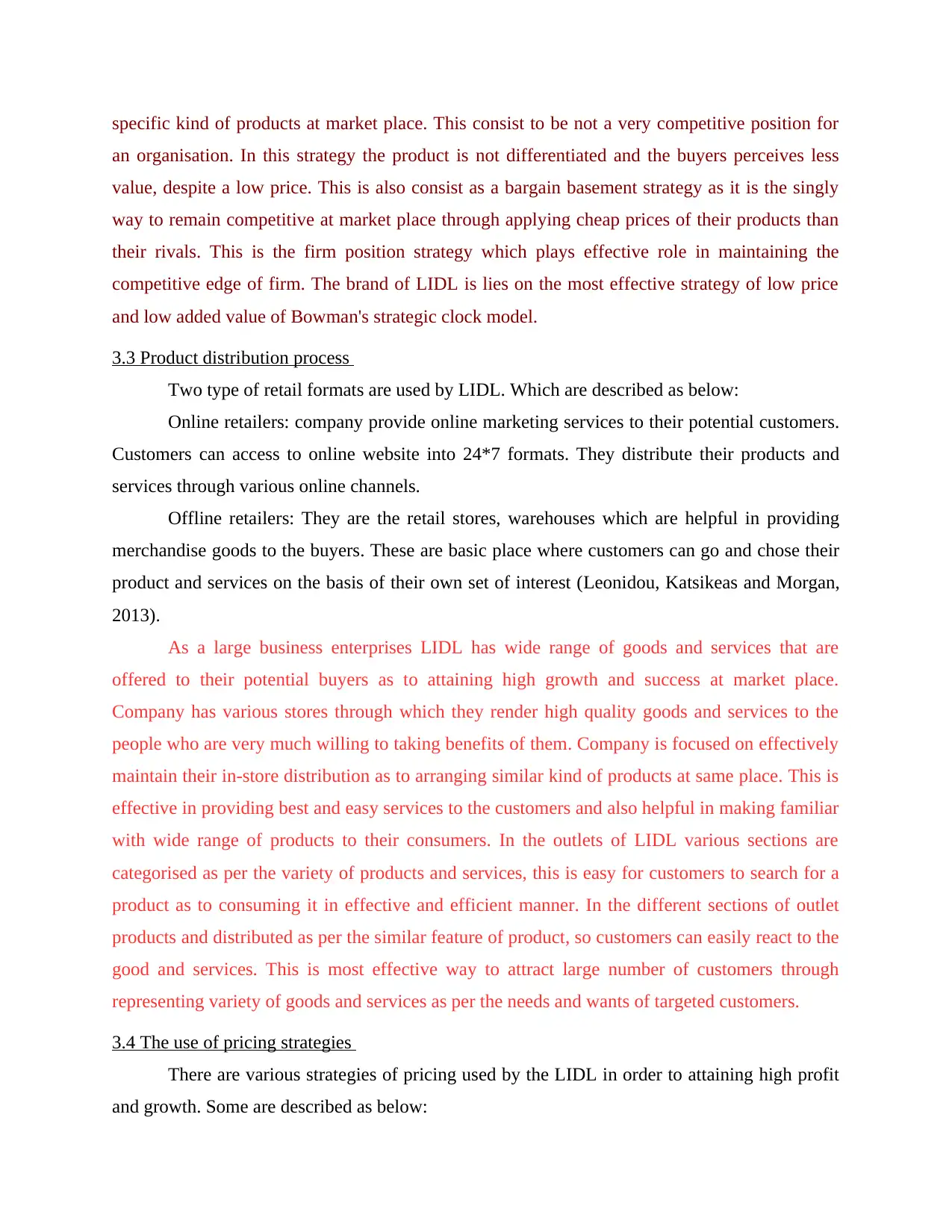
specific kind of products at market place. This consist to be not a very competitive position for
an organisation. In this strategy the product is not differentiated and the buyers perceives less
value, despite a low price. This is also consist as a bargain basement strategy as it is the singly
way to remain competitive at market place through applying cheap prices of their products than
their rivals. This is the firm position strategy which plays effective role in maintaining the
competitive edge of firm. The brand of LIDL is lies on the most effective strategy of low price
and low added value of Bowman's strategic clock model.
3.3 Product distribution process
Two type of retail formats are used by LIDL. Which are described as below:
Online retailers: company provide online marketing services to their potential customers.
Customers can access to online website into 24*7 formats. They distribute their products and
services through various online channels.
Offline retailers: They are the retail stores, warehouses which are helpful in providing
merchandise goods to the buyers. These are basic place where customers can go and chose their
product and services on the basis of their own set of interest (Leonidou, Katsikeas and Morgan,
2013).
As a large business enterprises LIDL has wide range of goods and services that are
offered to their potential buyers as to attaining high growth and success at market place.
Company has various stores through which they render high quality goods and services to the
people who are very much willing to taking benefits of them. Company is focused on effectively
maintain their in-store distribution as to arranging similar kind of products at same place. This is
effective in providing best and easy services to the customers and also helpful in making familiar
with wide range of products to their consumers. In the outlets of LIDL various sections are
categorised as per the variety of products and services, this is easy for customers to search for a
product as to consuming it in effective and efficient manner. In the different sections of outlet
products and distributed as per the similar feature of product, so customers can easily react to the
good and services. This is most effective way to attract large number of customers through
representing variety of goods and services as per the needs and wants of targeted customers.
3.4 The use of pricing strategies
There are various strategies of pricing used by the LIDL in order to attaining high profit
and growth. Some are described as below:
an organisation. In this strategy the product is not differentiated and the buyers perceives less
value, despite a low price. This is also consist as a bargain basement strategy as it is the singly
way to remain competitive at market place through applying cheap prices of their products than
their rivals. This is the firm position strategy which plays effective role in maintaining the
competitive edge of firm. The brand of LIDL is lies on the most effective strategy of low price
and low added value of Bowman's strategic clock model.
3.3 Product distribution process
Two type of retail formats are used by LIDL. Which are described as below:
Online retailers: company provide online marketing services to their potential customers.
Customers can access to online website into 24*7 formats. They distribute their products and
services through various online channels.
Offline retailers: They are the retail stores, warehouses which are helpful in providing
merchandise goods to the buyers. These are basic place where customers can go and chose their
product and services on the basis of their own set of interest (Leonidou, Katsikeas and Morgan,
2013).
As a large business enterprises LIDL has wide range of goods and services that are
offered to their potential buyers as to attaining high growth and success at market place.
Company has various stores through which they render high quality goods and services to the
people who are very much willing to taking benefits of them. Company is focused on effectively
maintain their in-store distribution as to arranging similar kind of products at same place. This is
effective in providing best and easy services to the customers and also helpful in making familiar
with wide range of products to their consumers. In the outlets of LIDL various sections are
categorised as per the variety of products and services, this is easy for customers to search for a
product as to consuming it in effective and efficient manner. In the different sections of outlet
products and distributed as per the similar feature of product, so customers can easily react to the
good and services. This is most effective way to attract large number of customers through
representing variety of goods and services as per the needs and wants of targeted customers.
3.4 The use of pricing strategies
There are various strategies of pricing used by the LIDL in order to attaining high profit
and growth. Some are described as below:
⊘ This is a preview!⊘
Do you want full access?
Subscribe today to unlock all pages.

Trusted by 1+ million students worldwide
1 out of 20
Related Documents
Your All-in-One AI-Powered Toolkit for Academic Success.
+13062052269
info@desklib.com
Available 24*7 on WhatsApp / Email
![[object Object]](/_next/static/media/star-bottom.7253800d.svg)
Unlock your academic potential
Copyright © 2020–2025 A2Z Services. All Rights Reserved. Developed and managed by ZUCOL.





